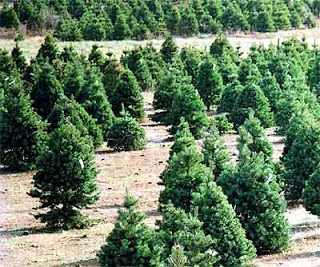Why Buy a Real Christmas Tree?
Many consumers will be asking themselves that question this holiday season.
In this age of environmental awareness it’s appropriate to know a favorite family holiday tradition of choosing a real Christmas tree over an artificial tree is still the environmentally sound choice.
“What could be simpler or more natural?” says Bob Scott, President of the National Christmas Tree Association. “Buying a real Christmas tree is definitely an environmentally sound choice.”
“Consumers are showing their preference for real, natural products that are socially conscious. Many young families are attracted to the tradition of celebrating Christmas with a real tree in their home,” explained Scott.
Christmas tree farms stabilize soil, protect water supplies and provide refuge for wildlife while creating scenic green belts. Often, Christmas trees are grown on soils that could not support other crops.
A benefit to the atmosphere, real Christmas trees absorb carbon dioxide and other gases, emitting fresh oxygen. This helps prevent the earth-warming “greenhouse effect”. One acre of Christmas trees produces the daily oxygen requirement for 18 people. With approximately one million acres producing Christmas trees in the United States, that translates into oxygen for 18 million people every day. For every real Christmas tree harvested, three seedlings are planted in its place.
Real Christmas trees are an all-American, recyclable resource. Artificial trees, most of which are manufactured in Korea, Taiwan or Hong Kong, consist of plastics and metals that aren’t biodegradable. When disposed of, the artificial trees will never deteriorate. Their effects on our environment are evident and will remain for countless generations.
Give a gift back to the environment!
- Real Christmas trees are an all-American product, grown in all 50 states, including Alaska and Hawaii. Most artificial trees are manufactured in Korea, Taiwan, or Hong Kong.
- Real trees are a renewable, recyclable resource. Artificial trees contain non-biodegradable plastics and metals.
- For every real Christmas tree harvested, 2 to 3 seedlings are planted in its place.
- There are about 1 million acres in production for growing Christmas trees. Each acre provides the daily oxygen requirements of 18 people.
- There are about 15,000 Christmas tree growers in the U.S., and over 100,000 people employed full or part time in the industry.
- There are approximately 5,000 choose and cut farms in the U.S.
- It can take as many as 15 years to grow a tree of average retail sale height (6 feet), but the average growing time in 7 years.
- The top selling Christmas trees are: Balsam Fir, Douglas Fir, Fraser Fir, Noble Fir, Scotch Pine, Virginia Pine and White Pine.
It’s Environmentally wrong to buy and use plastic trees!
Consider these important facts…
- Fake trees and wreaths are made from nonrenewable petroleum.
REAL Christmas trees and wreaths do not harm our environment and our resources… they are produced as an agricultural crop. Each year Christmas tree growers replace cut trees with a new crop of seedlings. - When a fake tree catches fire, it puts dangerous toxic fumes into the air.
A properly cared-for REAL Christmas tree will not catch fire easily. If and when it does, its fumes will certainly not be as toxic. In addition, one acre of REAL Christmas trees remove carbon dioxide from the atmosphere and produces enough oxygen for 18 people. - Fake trees cannot be recycled. When they are disposed of in a sanitary landfill, they will not disintegrate, but will remain there forever, taking up increasingly scarce landfill space.
Our cities today are faced with a critical shortage of sanitary land fill space. Many of them, and states as well, have passed laws prohibiting disposal of REAL Christmas trees in a landfill. REAL trees are thus being used in various helpful ways when disposed of…such as ground-up mulch to replenish the soil, fish habitat and other useful methods.But, what about disposal of fake Christmas trees? No legislation has yet been passed to prohibit their disposal in a landfill. A fake Christmas tree has no use whatsoever when disposed of, except to continue taking up space in critically-needed landfill space.
- Fake trees are manufactured mainly outside of the United States.
We hear much today about our economy being faced with a loss of jobs. Why do we continue to promote loss of jobs in the Christmas tree industry by buying and using fake Christmas trees and wreaths when very few fake trees and wreaths are made in the United States by American Labor.Thousands of jobs have already been lost in the Christmas tree industry because continued sale and use of fake trees and wreaths continues to be encouraged.
Over the years, the Christmas tree has come to symbolize the faith and hope of harmony among all mankind. This spirit is REAL and a REAL Christmas tree, when brought inside our homes, projects this feeling through its pleasant scent and natural warm beauty.
Wake Up, America!
Celebrate Christmas with a REAL Christmas tree and wreath, while helping protect our valuable nonrenewable environment.
